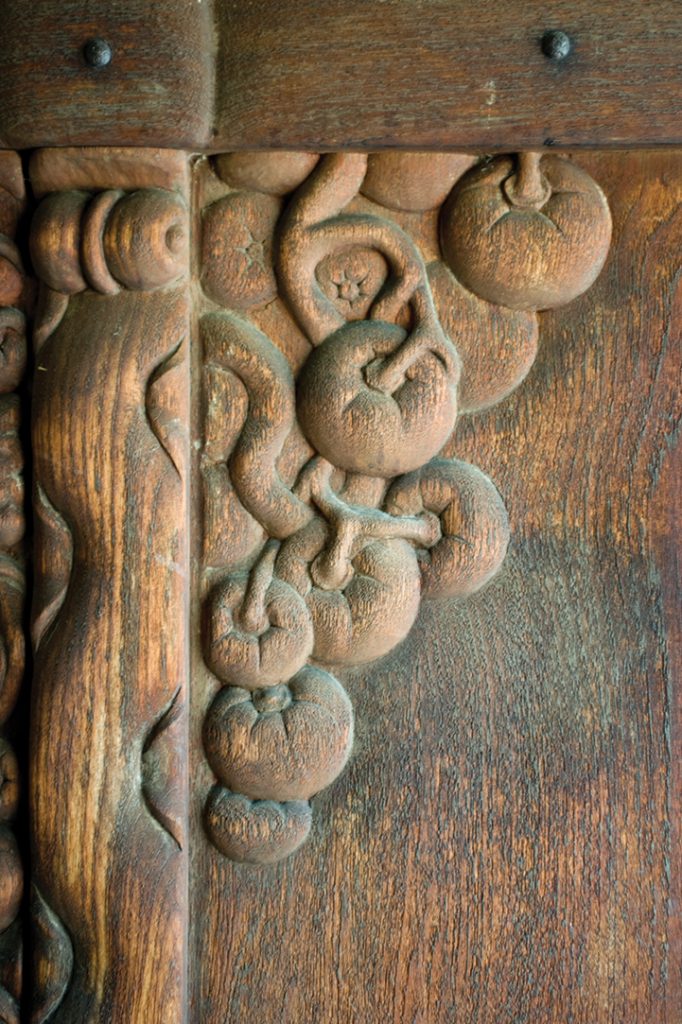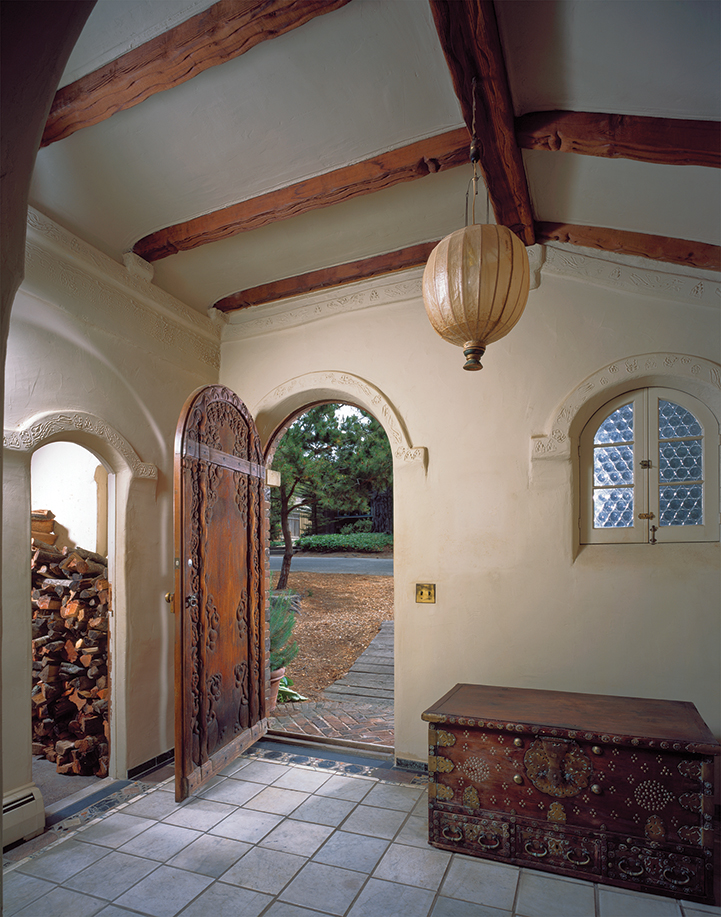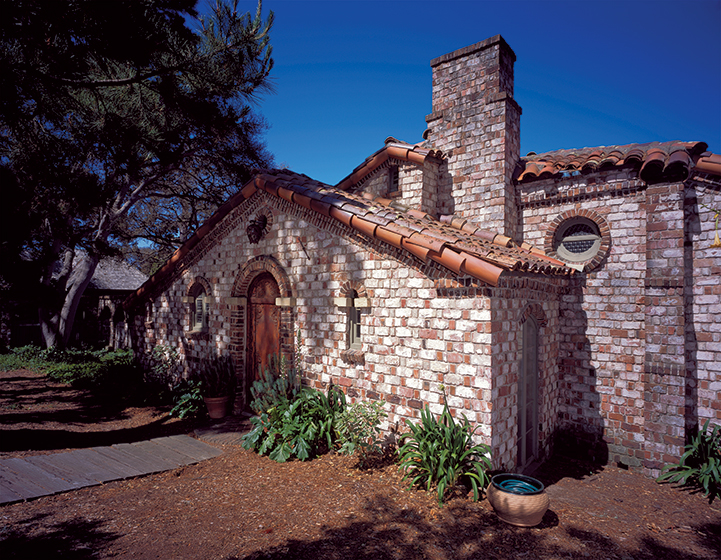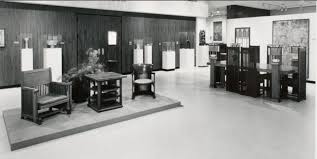CHARLES SUMNER GREENE STUDIO, CARMEL-BY-THE-SEA
~by Ted Wells~
I’m lying on the floor, on my back, in Charles Sumner Greene’s studio in Carmel. A large fire in the fireplace banishes the autumn chill, and its flames generate the best golden light in the darkened space. The small, circular window, high on the wall near the upper-left corner of the chimney, is open. This diminutive oculus is the only window in the main room that faces the street—a choice that Charles Greene may have made to protect his privacy and that of the many kindred spirits he welcomed inside during his time here.
I study the patterns Greene carved into the two large beams spanning the ceiling and the decorative impressions his children helped to stamp into the wet plaster nine decades ago, then a shadow races across the mantle; it’s a bat. The tiny creature circles the room in silent determination, its shadow growing and shrinking on the walls and ceiling in the undulating firelight. The atmosphere suddenly feels charged, as if now and then and tomorrow are all occurring at the same time—a circle. I’m motionless, struck with the notion that Charles has just stepped out to fetch more firewood.
Charles Greene intended for his studio to serve as a salon for what he hoped would be a growing Bohemian Culture in Carmel
The best spaces always feel timeless. When you’re in them, especially when alone and doing very little other than experiencing the moment, there’s virtually no perception of time. The space is either old or new and neither old nor new at the same time. And the architecture—because it’s good—feels fully alive simply because you’re present within it.
I think Charles would tell you that his studio has never been a static, defined space. Archival photos of the main room show that it was always in transition; objects would come and go, as would people. Charles created the objects seen in the photos; others were things he collected: family mementos, local finds, a hodgepodge of visual delight and clutter that only an artist could gather. During certain periods, Greene’s studio contained great piles of things; other times just a few objects were placed in the space. Throughout the years, chairs, tables, sofas, a grandfather clock, and even a grand piano were rearranged in an ongoing search for meaning and practicality of use.

There’s something about Charles Greene’s studio that captures visitors’ attention minutes, not moments, after they enter it. When guests first approach the studio space from the foyer, they find themselves tight to the corner of the room with a diagonal view across it toward the full-width, north-facing skylight of corrugated glass. It’s definitely a drama moment, and they usually gaze around the large space for a while before the questions inevitably begin: What is this room? Is it a painting studio? A sculpture studio? A recital hall? A dining room? As difficult as it may sometimes be, I try never to answer those questions, because a few minutes after experiencing the room, visitors seem to find the answers themselves: “This is an amazing space. I love it here.”
Old architecture lived because it had a purpose, as William Lethaby reminds us in Architecture, Mysticism and Myth, a book that Charles Greene used as a guide in understanding the secret meanings that lie deep within the human psyche and that are linked to ancient and universal symbolism. Modern architecture, to be real, must not be a mere envelope without contents. As César Daly says in his Hautes Etudes, if we would have architecture excite and interest, real and general, we must have a symbolism, immediately comprehensible by the great majority of spectators. At the studio, this is exactly what Charles Greene did: He created a place of freedom, confidence, light, and shadow that tells a very natural human story. The narrative begins at the threshold, where Greene carved opulent tomato vines into the heavy teak door. The vines and fruit symbolize our beginnings in life, represented by simple, round shapes. Without proper psychic nourishment, and occasional pruning, our quality and flavor—like that of any natural thing—is sure to diminish and we will wither on the vine.Once inside the studio space, the symbols and stories carved into the beams and doors and impressed into the plaster span a broad range of Eastern and Western philosophy: the earth and sky, the literal and figurative. Because Charles Greene intended for his studio to serve as a salon for what he hoped would be a growing Bohemian culture in Carmel, he chose symbols—leaves, vines, flowers, birds, ocean swells—that could be interpreted by different people in different ways, allowing visitors to truly personalize their experience in the space.

Like Greene’s studio, the Monterey Peninsula served as an escape for the creatively minded beginning in the early 1900s. This was because during the first four decades of the twentieth century, communities north in the Bay Area and south in Los Angeles were, at a fundamental level, politically and culturally conservative. However, Carmel, located somewhat in the geographical center of these two conservative regions, was affordable, casual, and open to personal exploration and self-expression. So, for a time, artists, writers, poets, actors, photographers, musicians, dancers, philosophers, and intellectuals, often inspired by the poet George Sterling, came to this area jutting west into the Pacific to find autonomy and, many hoped, personal rebirth. Soon Carmel became a hangout and hideout for anyone who needed someplace to live, think, play, and create with freedom.
Starting in the early 1920s, regularly scheduled arts and philosophy events took place behind the walls of Charles Greene’s studio. Charles, who never considered himself stuck in the invented romanticism of the American Arts & Crafts movement, embraced the radical exploration that modernist thinking in Carmel allowed. Like his Bohemian compatriots, he saw the town, and his studio, as a kind of citadel against the repressive conservatism found in Pasadena and other parts of southern California. Hence, for fifteen years, the studio was one of the key places in Carmel where one could experience the arts, culture, and philosophy in a new way, in an intriguing setting, and without the strictures of tradition.
As if to encourage the flow of energy and ideas within the studio space, Greene chose to create a building without a single straight line. With its inspirational views of the distant surf at Point Lobos and the nearby silhouette of Robinson Jeffers’ stone Tor House Hawk Tower, guests at the studio could let their ideas take flight, allowing them to move within the building and escape with visions across the vast Pacific horizon.
As an aside, Robinson Jeffers, who was a poet and a builder, and Charles Greene, who was a builder and a poet, each constructed their stone and brick fortresses at the same time. At Tor House, the tower’s paving was a gift from Charles, remnants from Greene’s D.L. James House in Carmel Highlands. Leftover marble pieces were also used in the studio foyer and bathroom.
In 1924, when Greene’s studio was completed, Rudolf Schindler visited from Los Angeles, joining his friends, Carmel residents and photographers Edward Weston and Johan Hagemeyer. Three years later, when Schindler’s progressively minded wife Pauline divorced him, she returned to live in Carmel. And for two years she edited the local newspaper, The Carmelite, bringing a modernist avant-garde character to the publication. Even her friend, and her husband’s former business partner, Richard Neutra, served as a contributing editor for the newspaper. In The Carmelite, Pauline would announce and review salon events at the Greene studio, as well as other artistic affairs throughout the peninsula. For a time, Carmel experienced a golden age of sorts; it truly was an artists’ community.
However, by 1939, with the U.S. government looking toward war with Germany as a solution to the morass of economic depression, it began acquiring more land in the Monterey Peninsula region for bases and military activities. To make accomplishing this goal easier, government information offices began promotional efforts that labeled the Bohemians of Carmel as radicals and socialists who should be suppressed. By 1940, with artistic and philosophical exploration in the area increasingly perceived as a threat, many of those who had moved from the Bay Area and Los Angeles to the Monterey Peninsula seeking creative asylum decided to return to urban life, where they could have increased anonymity, yet more influence. Soon afterward, Carmel became quiet, conservative, devoid of most avant-garde expression—and a bit dull. Despite the early efforts of people like Charles Greene, who built a gathering place that continues to encourage the creatively inclined among us to see beyond the ordinary, Carmel has not fully recovered.
I’m lying, still, on my back in the studio. Minutes later the bat, which seems to have satisfied its curiosity about what goes on behind the studio’s salvaged brick facade, stirs me from my wistful, circling imaginings by altering its course and exiting the tiny window just as quickly as it entered. But the flames continue, the shadows still dance, and I don’t move. ♦
Author’s Note:
Ted Wells is the manager of Guardian Stewardship, a non-profit involved in preservation and education, and creative director of Guardian Stewardship Editions. His latest book is Casting Shadows: Auguste Rodin. His books include Romantic Modern: The California Architecture of Harwell Hamilton Harris; Greene & Greene: Wood, Proportion, and Pattern (in three volumes); and Friendly Curves: Eva Zeisel. He is a contributor to the book Future Perfect: A History of The University of Southern California School of Architecture.
Editor’s Note:
Thank you to Ted Wells for arranging a special visit to theCharles Greene studio in May 2013 for our Northern California tour group.



Leave a Reply